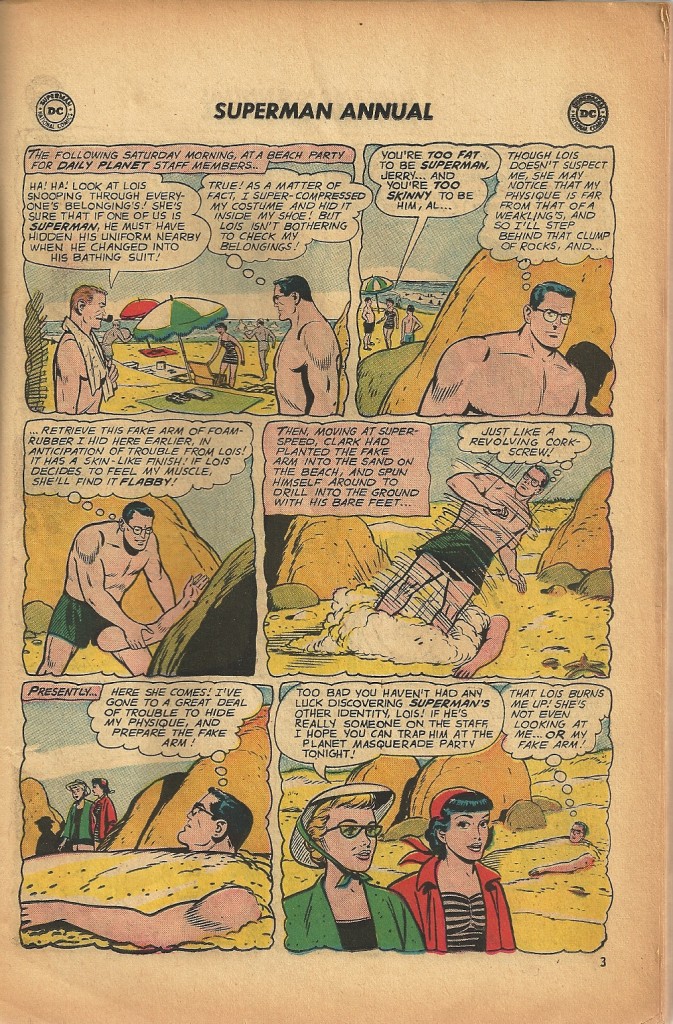 In 1964, Bob Dylan wrote, “The times, they are a’changin’.”
In 1964, Bob Dylan wrote, “The times, they are a’changin’.”
But forty-eight years ago, when I first read “When Lois First Suspected Clark Was Superman,” written by Jerry Siegel, with art by Al Plastino, in Superman Annual #8 (Winter 1963/1964), the times hadn’t changed yet. We were still living in a “Leave It To Beaver” world of relative naïveté and innocence, a situation reflected in all the media, especially comic books. We took that innocence for granted and, as a nine year old, I know I never gave the silliness of this story (originally published in Superman #135, February 1960) a second thought:
The staff of the Daily Planet is having a picnic at the beach where another employee comments in amusement to Clark Kent about Lois Lane’s “snooping through everyone’s belongings” because “she’s sure that if one of us is Superman, he must have hidden his uniform nearby when he changed into his bathing suit!”
Out of concern that Lois might notice his “physique is far from that of a weakling’s,” Clark came to the beach prepared. He’s brought a fake arm made of foam rubber, which he’s “hid…in anticipation of trouble from Lois! It has a skin-like finish! If Lois decides to feel my muscle, she’ll find it flabby!” Clark then buries himself in the sand, leaving only his head and the fake arm exposed. Lois, of course, doesn’t give the milquetoast Kent a second look; after all, how could that weenie be Superman?
Clark’s reaction to getting exactly what he wanted after having “gone to a great deal of trouble to hide (his) physique, and prepare the fake arm”? “That Lois burns me up! She’s not even looking at me…or my fake arm!”
If you are looking for a definition of innocence, you won’t find one much better than the Superman stories of the 1950s and early 1960s. Editor Mort Weisinger had an uncanny feel for what would click with his ten-year old readership. In fact, it was only years later, as an adult, that I recognized the genius of Weisinger’s approach: the stories were about what a ten year old would do with Superman’s powers! He would have great adventures in outer space, hang out in his secret Fortress of Solitude, and play tricks on his sister and mom. Just as the concurrent stories starring Batman and Robin were idealized father/son or big brother/kid brother tales (yeah, yeah, yeah, they slept in the same bedroom, Dr. Wertham, but so what? I shared a room with two brothers, didn’t I?), Superman was presented squarely from the point of view of his adolescent readers.
Flash forward a few decades.
Mort Weisinger is gone. Comic books, which once sold in the hundreds of thousands per issue, now sell in the tens of thousands (if they’re lucky), and ten year olds don’t read them anymore.
A story like “When Lois First Suspected Clark Was Superman” couldn’t be published today, at least not with a straight face.
Some would say that comics have grown up and matured.
In the 1960s, if a character was shown holding a limb in a comic book, it was made of foam rubber.
In the 2000s, it’s flesh and blood, likely freshly (and graphically) ripped from somebody’s body.
I call it gratuitous and puerile.
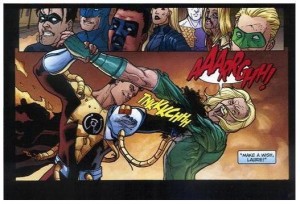 And I think we’ve lost something important.
And I think we’ve lost something important.
And not just our good taste.
Tags: Al Plastino, Clark Kent, dismemberment, Fortress of Solitude, Jerry Siegel, Lois Lane, Superman
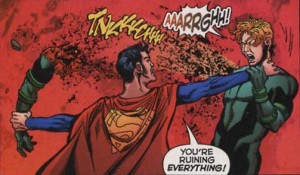
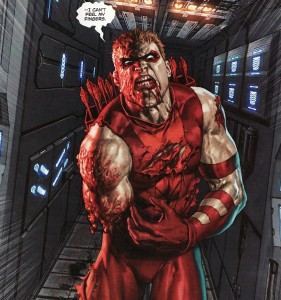
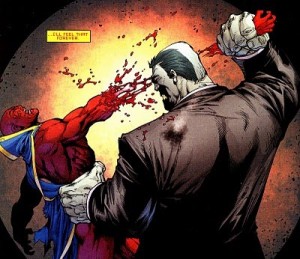
“And I think we’ve lost something important.”
yeah – an arm AND multiple heads – because no one has a brain to accompany the lack of writing ability or editorial taste.
I’m still reading Mort and Julie’s books before bed after an exhausting day covering news of the day (and/or what passes for it) I need relief. . Give me Lois and Lana having a super-chef war and a viking robot that loves Jimmy to make Lucy jealous ANY DAY of the WEEK. Fantastic, sincere storytelling with a heart AND a soul to inspire –not depress further. Thanks PK for a great post!
I remember that very issue, Paul–but I didn’t find it silly. I found it creepy. In those Mort years, Superman’s biggest enemy wasn’t Lex Luthor–it was Lois Lane. It was certainly the person he was most scared of. (And when Schaffenberger did those Angry Lois and Angry Lana faces–brrrr!) Superman stories were about this colossally strong guy who could fly–and all this ten year old got was Super-breath, super-ventriloquism, Red Kryptonite, Superman robots–and hiding from women. OTOH, my favorite hero, Adam Strange, had dazzling alien cities, strange planets, real dangers, and a hero with a beautiful girlfriend who adored him. I was too young to analyze why, but I always came away from Supes disappointed, and from Mystery in Space exhilarated.
And then I turned 11 and discovered Lee and Kirby, and never looked back.
The casual blood of so much of this present-day stuff disgusts me like it does you–but Stan and Jack (and Gardner and Carmine) could give High Adventure and a Sense of Wonder with no blood, no cusswords, and no nudity.
(and if I had been an editor, I would have pointed out that if Lois had squeezed Clark’s arm, she would have found the arm flabby–but also paralytic. Just Sayin’.)
And forewarned is half an octopus.
A PERFECT juxtaposition of then and now that left me sad, disgusted, and as always, glad I read the entry. As a young girl, those Lois & Lana stories from the 60’s not only kept me interested, but showed me the power of The Woman as someone to be both lusted after and feared, and what could be better than both? 😉
I was shocked at the graphic gore in today’s books, and I’m more than a little concerned that young boys digest that kind of high def blood lust as a matter of course. The way comics wrote on our psyches can’t be different for them, but the images and the messages most certainly are.
Just as a side-note, my five-year old loves the ’67 Spiderman animated series, but finds the modern tv shows terrifying.
Though it may seem ‘gratuitous’, some level of injury detail is necessary in order to give it grounding in reality and give it authenticity. After all, when these god like beings punch they do so with the force of a truck or a missile.
Similarly when one uses abilities that project substance or energy such as Mr Freeze’s ray or the heat vision of Superman, it is likewise important to show those physiological effects for the same reason.
I agree that it is wrong to sensationalise violence, however, by showing its effects on the body and the emotional impact in unflinching detail this can emphasise the tragedy and senselessness of it.
In fact, this is done to great effect in comics such as Miracleman, Uber (a dystopian series set in WWII in which there is a superhuman arms race between the Axis powers and the Allies), The Watchmen, Hellblazer (the early volumes) and Jaegir (2000AD).
Also, as well as in the context of superheroes and comic heroes which are based on ancient mythologies- Slaine (2000AD) for example is based heavily on the Ulster and Fenian cycles (translated by Catholic monks from Ogham) of Celtic mythology with its eponymous hero being similar to Cúchulainn and is characteristically brutal- it is also neccessary to depict violence and trauma in the context of war.
This is done well in Notes from a Defeatist, Palestine and the Fixer by Joe Sacco as well as Dougie’s War Rodge Glass, Art: Dave Turbitt which shows the realities of PTSD.
In Pat Mills’ Black Man’s Burden (published in Crisis and illustrated by the late John Hicklenton), there is the dark reflection of the Tarzan coin with depictions of massacres of Kenyans during the Mau Mau Rebellion.
From the look of it, the tone is similar to many of the documentaries I have watched about the atrocities committed in Vietnam (a war started by the tragic mistaking of the decline of colonialism for the hypothetical and McCarthian ‘Domino theory’) mentioned in books such as Kill Anything That Moves which deals with the tragic and predictable outcome of such a mandate.
https://patmills.wordpress.com/2012/10/30/hammerstein-vs-the-us-president/
Also, another important comic is Steve Beeny’s Rebellion 1920 in which Churchill sanctioned the saturation bombing campaign on Iraq and advocated the use of poison gas on the Kurds- of course when Saddam did it, it was very naughty but when Churchill did it it was regrettable but okay.
https://patmills.wordpress.com/tag/charleys-war/
Though war seems to have been romanticised in early comics such as Commando and Warlord as well as imperialistic and propagandist ‘Boy’s Own’ adventure stories, it is important to show the reality. One example of such dark romanticism would be the tales told of the Russo-Japanese war of Feb 1904 – Sept 1905.
“A Soldier of Japan: A tale of the Russo-Japanese War. Illustrated Written by Captain F.S. Brereton. Published by Blackie & Sons
The opening incident of this war was as great a surprise to Valentine Graham and his father as to the Russians, for their junk lay opposite Port Arthur on February 8, 1904, and in spite of their signals was heavily shelled. They are rescued by the Japanese and indignant at their treatment, join the Mikado’s forces. Valentine promptly takes part in a second dash upon Port Arthur and becomes a prisoner. In time he is sent up-country with other prisoners which whom he contrives to escape. They join a band of Hunhuse brigands and have a desperate encounter with the Cossacks. A week later they fall in with Kuroki’s army and take part in the battle of the Yalu. Thereafter numerous adventures befall the hero who becomes noted throughout Manchuria for dash and intrepidity.
KOBO-: A Story of the Russo-Japanese War. Illustrated Written by Herbert Strang Published by Blackie & Sons
Bob Fawcett sent out to Japan just before the outbreak of the war to test the range finding apparatus of the Japanese fleet, has the good fortune to do a slight service to Kobo San, the descendant of an ancient Samurai family and high in the Government Service. When summoned to take up his duties, Bob shares in some of the most noteworthy naval actions of the war. These are, however, only the prelude to as exciting a series of adventures onland as ever a boy went through. Bob is captured by Cossacks, escapes, falls in with a band of Manchus, the leader of who is an old enemy of Kobo, is besieged with Kobo in a Korean temple and after defeating the besiegers reaches the army of General Kuroki in time for the Battle of the Yalu.”
In other words, war was treated in these stories as nothing more than a backdrop for a series of adventures with characteristically jingoistic depictions of the ‘enemy’- using and creating prefabricated archetypes rather than seeing them as individuals. And of course those ‘bad’ Russians (after all, they were a rival empire to Britain) deserved everything they got.
http://russojapanesewar.com/boys-own.html
In other words it is necessary to depict some level of violence in comics about history for example in works about the Aztecs, the Celts, the Neo-Assyrian Empire, Mongolia under the Bloody White Baron (Roman von Ungern-Sternberg), Vlad Tepes III’s Romania and Han Dynasty China under Wudi (instigated aggressive policies against the nomadic Xiongnu) and the Cathar Crusade fronted by Simon de Montfort in order to give it some historical veracity.
Though it may seem distasteful to contemplate or even look at, in my opinion, it is more distasteful that such suffering should exist in the real world. After all, does a child who has stepped on a landmine or a victim of an atrocity such as the Rwandan genocide think “quickly, I must cover my face because someone squeamish may see me”. No. Reality has no censorship.
http://teaching.quotidiana.org.....ocide.html
Too many “War is Hell” films and comics masquerade as anti-war stories. They’re not. E.g. Full Metal Jacket and Apocalypse Now were watched by US soldiers to psyche them up before they invaded Iraq. No-one could read Charley’s War or Dougie’s War and want to invade anyone and that means they’ve done their job.